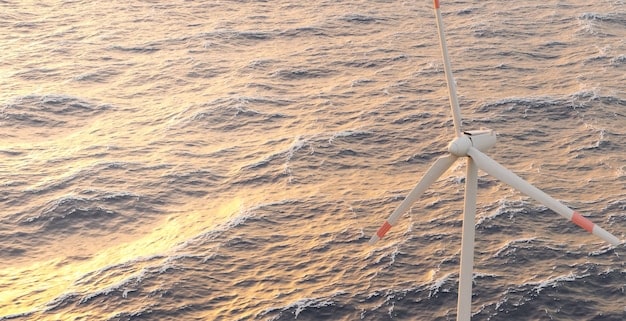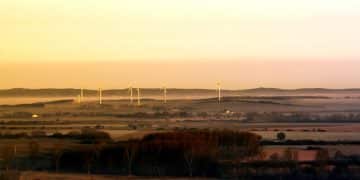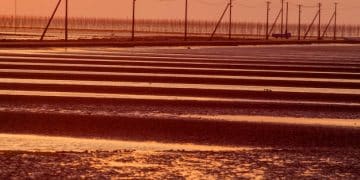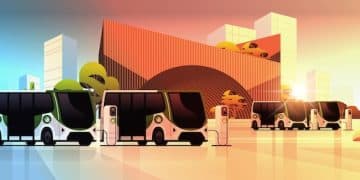Offshore Wind Farms: Reshaping the US Energy Landscape by 2035

Offshore wind farms are poised to significantly impact the US energy landscape by 2035, contributing a substantial amount of renewable energy, fostering economic growth, and influencing policy and infrastructure development across the nation.
How will the development of offshore wind farms affect the US energy landscape by 2035? This burgeoning industry promises to revolutionize how America generates and distributes power, offering a clean, sustainable alternative to traditional fossil fuels.
The Current State of US Energy and the Push for Renewables
The United States is currently heavily reliant on fossil fuels, but growing environmental concerns and the increasing cost-competitiveness of renewable energy sources are driving a significant shift. This section explores the pressures stimulating the search for alternative energy and how offshore wind farms offer a viable solution
Reliance on Fossil Fuels and its Consequences
For decades, the US energy sector has been dominated by fossil fuels such as coal, oil, and natural gas. These resources have powered industries and homes, but they also contribute significantly to greenhouse gas emissions and air pollution, leading to climate change and public health issues.
The Rise of Renewable Energy: A Necessity
The push for renewable energy is no longer just an environmental concern but an economic and social imperative. Renewable energy sources like solar, wind, and hydropower offer a pathway to a cleaner, more sustainable future. Offshore wind energy, in particular, has the potential to provide a massive source of clean power to coastal regions.
- Growing public awareness of climate change and its impacts.
- Government policies and incentives promoting renewable energy development.
- Technological advancements making renewable energy more efficient and cost-effective.
- Increasing demand for clean energy from businesses and consumers.
The transition to renewable energy is essential for reducing the nation’s carbon footprint and mitigating the effects of climate change. Offshore wind farms represent a critical component of this transition, providing a reliable and scalable source of clean electricity.
Offshore Wind Technology: How It Works and Why It’s Promising
Offshore wind technology harnesses the power of wind far out at sea to generate electricity. This section delves into the technology behind offshore wind farms, their advantages over land-based wind farms, and the reasons they are viewed as a promising energy source.
The Basics of Offshore Wind Turbines
Offshore wind turbines are similar to their land-based counterparts but are designed to withstand the harsh marine environment. These turbines capture wind energy using large rotor blades, which turn a generator to produce electricity. The electricity is then transmitted to shore via underwater cables.
Advantages Over Land-Based Wind Farms
Offshore wind farms offer several advantages over land-based wind farms. Winds tend to be stronger and more consistent over the ocean, resulting in higher energy production. Additionally, offshore wind farms can be located closer to major population centers along the coast, reducing transmission losses and infrastructure costs.

- Stronger and more consistent wind speeds offshore compared to onshore.
- Reduced visual impact as turbines are located far from shore.
- Lower environmental impact on terrestrial ecosystems.
- Proximity to coastal population centers reduces transmission costs.
Offshore wind technology is becoming increasingly sophisticated, with larger turbines and more efficient designs. These advancements make offshore wind a competitive and reliable source of renewable energy.
Projected Growth of Offshore Wind Capacity in the US by 2035
Experts predict that the US offshore wind capacity will grow dramatically by 2035. This section examines the ambitious targets set by the government, the projects currently in development, and the factors driving this growth.
Government Targets and Policies
The US government has set ambitious targets for offshore wind development, aiming to deploy tens of gigawatts of offshore wind capacity by 2030. These targets are supported by policies such as tax incentives, grants, and streamlined permitting processes.
Key Offshore Wind Projects in Development
Several large-scale offshore wind projects are currently in development along the East Coast. These projects include Vineyard Wind, South Fork Wind, and Ocean Wind, which are expected to come online in the coming years and provide clean energy to millions of homes.
The projected growth of offshore wind capacity in the US is driven by a combination of factors, including favorable government policies, technological advancements, and increasing demand for clean energy. As more projects come online, offshore wind is expected to become a major contributor to the US energy mix.
Economic Impacts of Offshore Wind Development
Developing offshore wind farms has significant economic implications, creating jobs, stimulating local economies, and attracting investment. This section explores the economic benefits associated with the offshore wind industry and its potential to revitalize coastal communities.
Job Creation and Workforce Development
The offshore wind industry creates jobs in various sectors, including manufacturing, construction, engineering, and operations. Workforce development programs are being established to train workers for these specialized jobs, ensuring a skilled workforce is available to support the industry’s growth.
Investment and Local Economic Stimulus
Offshore wind projects require significant investment, providing a boost to local economies. Ports, shipyards, and other infrastructure facilities are being upgraded to support the construction and maintenance of offshore wind farms. This infrastructure development creates additional economic opportunities for coastal communities.
- Increased tax revenues for state and local governments.
- Development of new industries and supply chains.
- Attraction of foreign investment and partnerships.
- Revitalization of coastal communities through job creation and infrastructure upgrades.
The economic benefits of offshore wind development are substantial and far-reaching. By creating jobs, stimulating local economies, and attracting investment, the offshore wind industry can play a key role in the nation’s economic recovery and long-term prosperity.

Environmental Considerations and Mitigation Strategies
While offshore wind energy is a clean and renewable source of power, it also poses potential environmental impacts. This section discusses the environmental considerations associated with offshore wind development and mitigation strategies to minimize these impacts.
Potential Environmental Impacts
Offshore wind farms can have potential impacts on marine life, including birds, fish, and marine mammals. Construction activities can generate noise and disrupt marine habitats. Operational turbines can pose a collision risk for birds and interfere with marine navigation.
Mitigation Strategies and Best Practices
To minimize the environmental impacts of offshore wind development, various mitigation strategies are being implemented. These strategies include conducting thorough environmental impact assessments, using noise reduction technologies during construction, and implementing measures to protect marine life.
By carefully considering the potential environmental impacts and implementing appropriate mitigation strategies, the offshore wind industry can minimize its footprint and ensure the sustainable development of this valuable renewable energy resource.
Policy and Regulatory Landscape for Offshore Wind in the US
The development of offshore wind in the US is governed by a complex set of policies and regulations. This section provides an overview of the policy and regulatory landscape, including federal and state initiatives, and the challenges and opportunities they present.
Federal and State Initiatives
The federal government, through agencies such as the Bureau of Ocean Energy Management (BOEM), plays a key role in leasing offshore areas for wind energy development. States also have their own policies and incentives to promote offshore wind, including renewable portfolio standards and tax credits.
Challenges and Opportunities
Navigating the policy and regulatory landscape can be challenging for offshore wind developers. Streamlined permitting processes, clear policy signals, and strong stakeholder engagement are essential for accelerating the deployment of offshore wind capacity in the US.
- Need for clear and consistent federal and state policies.
- Importance of stakeholder engagement and community support.
- Challenges related to grid integration and transmission infrastructure.
- Opportunities for innovation and technological advancements.
The policy and regulatory landscape will continue to evolve as the offshore wind industry matures. By addressing the challenges and seizing the opportunities, the US can unlock the full potential of offshore wind energy.
| Key Point | Brief Description |
|---|---|
| 🌊 Renewable Energy | Offshore wind farms offer a significant source of clean, renewable energy. |
| 💼 Economic Boost | The industry stimulates job creation and economic growth in coastal communities. |
| 🎯 Policy Support | Government targets and policies promote offshore wind development. |
| 🌍 Environmental Considerations | Mitigation strategies minimize potential impacts on marine life. |
FAQ
▼
Currently, the US has a few operational offshore wind farms, primarily located off the East Coast. Several large-scale projects are in various stages of development and permitting.
▼
By 2035, offshore wind farms could produce tens of gigawatts of electricity, enough to power millions of homes and significantly reduce reliance on fossil fuels.
▼
Challenges include high upfront costs, regulatory hurdles, grid integration issues, and concerns about potential environmental impacts on marine ecosystems.
▼
Environmental impact assessments, noise reduction technologies during construction, and measures to protect marine life are being implemented to mitigate potential environmental impacts.
▼
Offshore wind projects create jobs in manufacturing, construction, engineering, operations, maintenance, and various supporting industries within the supply chain.
Conclusion
The development of offshore wind farms is set to reshape the US energy landscape significantly by 2035, contributing a substantial amount of clean, renewable energy, stimulating economic growth, and influencing policy and infrastructure development across the nation. Overcoming the challenges and seizing the opportunities presented by offshore wind will be critical in achieving a sustainable energy future for the United States.





